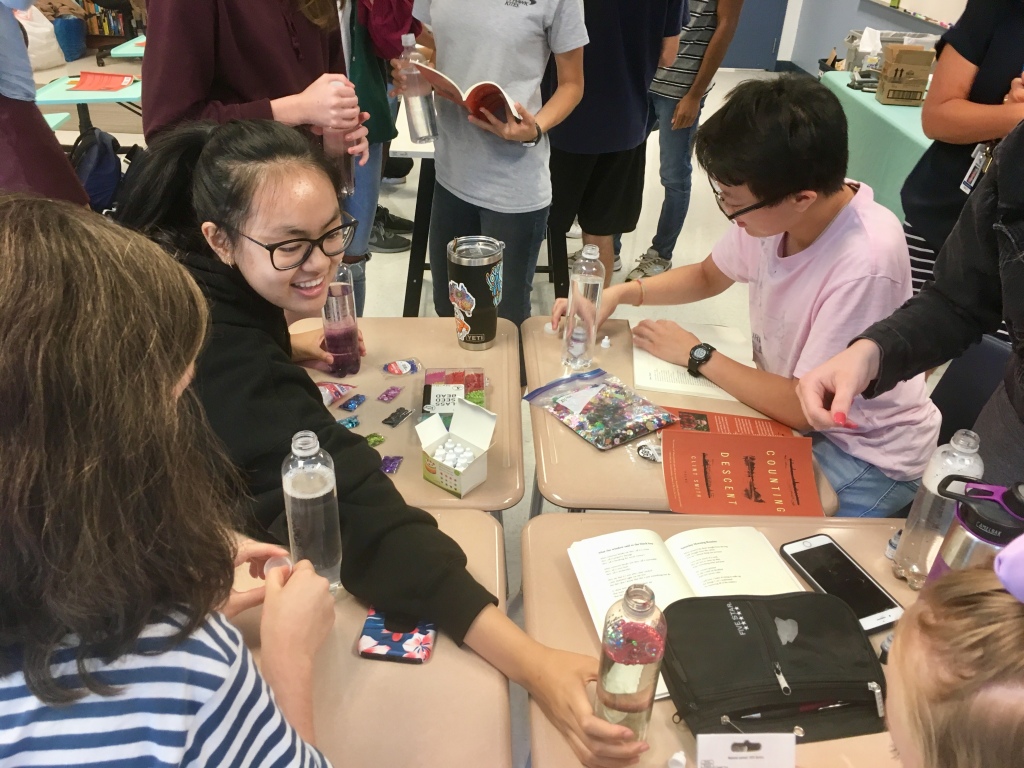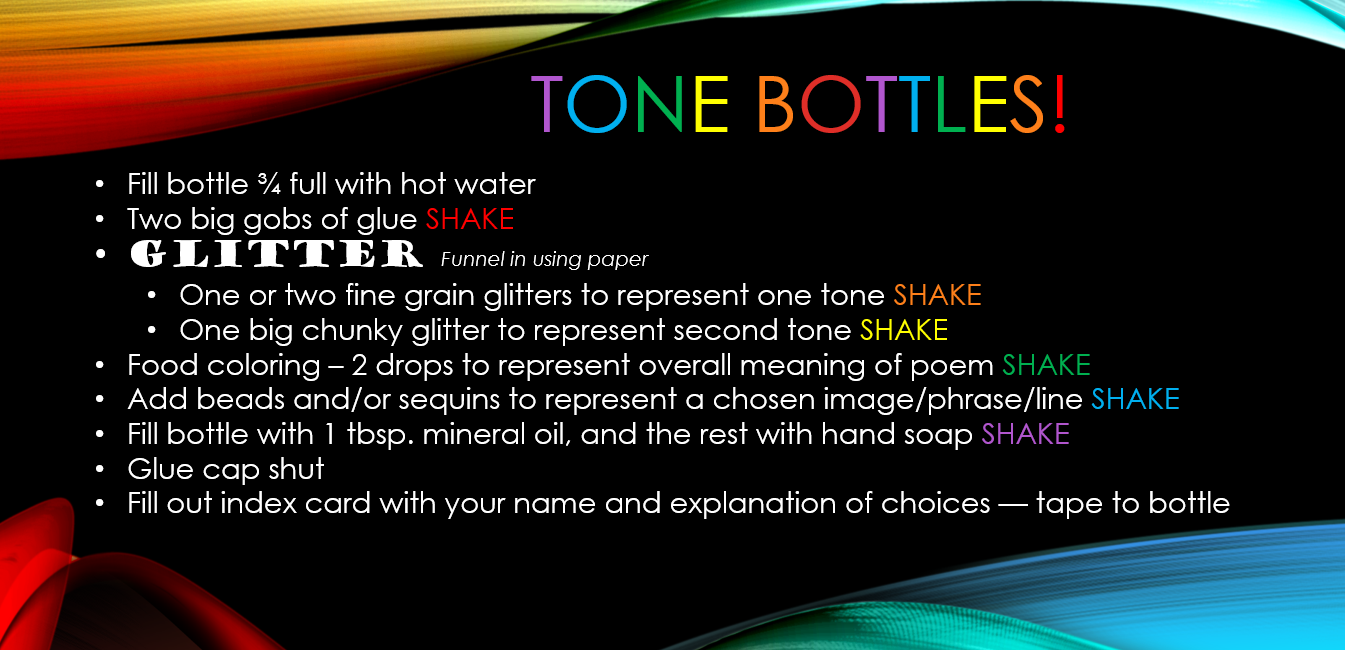
Today’s post is by guest author Valerie A. Person. In her 25th year at Currituck County High School, Valerie teaches honors and academic English II as well as AP Literature and Composition. She agrees passionately with Virginia Woolf’s “teaching without zest is a crime,” striving to find engaging and meaningful ways for her students to learn.
One of the tenets of AP Literature and Composition is helping students recognize, understand and explain complexity in literature. Students often hear me instruct them to “peel that onion, baby. Peel it.” With poetry playing a prominent role on the AP exam, I’ve found myself revising my lessons for sophomores, scaffolding for them to do more work with abstraction, particularly as it features in poetry. Get comfortable in the gray, folks. In this journey to guide students to move from the unknown to the known, I find using concrete, hands-on lessons to illustrate that gray provides tremendous benefits for students.
Exploring complexity, students track tone shifts in poetry and pull from their tone vocabulary to name the tones and justify them with textual evidence.

Finished products.
In the past, that’s where I ended, but students still did not demonstrate that they fully understood the nuances of tones in a work. Back in March, my school held inservice PD hosted by our Arts and CTE teachers. In one session, the Parent and Child Development teacher taught us how to make “calming bottles” that she has her students make. Making the bottles was so relaxing and engaging. Seeing the choices of glitter and how they looked when combined, my mind began brainstorming how I might incorporate them into my classes with connection to the content I teach. And that’s where the idea for the tone bottle was born. I’ve had students use paint strips to work with tone in text, but tone bottles would help students see both the individual colors of a poem along with the combined look.
 Here’s the lesson I designed. With our focus on #TeachLivingPoets this semester, I asked my sophomores to go back and choose one poem by a living poet that spoke to them. Students read through a lot of the classroom library books of poetry. Once they selected one they liked, they set up a Google doc and typed that poem onto a google doc. I asked them to do this because I think there is value in typing out a poem, paying attention to the lining, the punctuation, the perhaps unconventional spelling and more.
Here’s the lesson I designed. With our focus on #TeachLivingPoets this semester, I asked my sophomores to go back and choose one poem by a living poet that spoke to them. Students read through a lot of the classroom library books of poetry. Once they selected one they liked, they set up a Google doc and typed that poem onto a google doc. I asked them to do this because I think there is value in typing out a poem, paying attention to the lining, the punctuation, the perhaps unconventional spelling and more.
Copying a poem gives a student more time to hear the words and fall in love with the essence of the poem, observing more acutely the nuances.
Once they copied the poem and shared with me, they used the TPCASTT protocol to break down the poem. We’ve done TPCASTT earlier in the semester, so students are very familiar with this process. I asked students to mark the places where the tone shifted and provide a written explanation of why they saw shifts where they did. Paying close attention to the shifts, students selected three adjectives to describe the tones of the poem. Since we have been studying SAT tone words this semester, most went directly to that bank to use. Students then matched up a specific color with each of those three words with an explanation of why. They then submitted their plans to me for me to make sure they were headed in the right direction before moving onto Part B of the Tone Bottle assignment.
In Part B, students used a plastic bottle with a cap. I asked students and faculty to donate their “empties” to me a couple of weeks before our project. I particularly like the FROST or ICE flavored water bottles as they are slender, smooth and tall, perfect for gazing at the finished tone bottles. Students fill their bottles three-fourths full with very warm or hot water. They then add 3 or 4 solid globs of clear Elmer’s glue. I’d say it ends up being about 2 Tablespoons. They put the cap on it and shake it up. They then add the 3 colors  of their glitter. One becomes the primary glitter, so they add a bit more of it. Students use paper to funnel the glitter. I provide a wide variety of color and grade of glitter from very fine to big glitter. I also provide food coloring for those who want to add a drop of one or two colors. Food coloring now comes not only in the standard primary colors but in neon tropical colors. Students add mineral oil and clear soap to their bottles to get a good texture and viscosity. They play around with the amounts of it, but the finished products are fabulous! They fill any remaining empty bottle space with more water. Then, they shake it, shake it, shake it. Having some chopsticks on hand helps, too, for student to use to break up any glitter clumps.
of their glitter. One becomes the primary glitter, so they add a bit more of it. Students use paper to funnel the glitter. I provide a wide variety of color and grade of glitter from very fine to big glitter. I also provide food coloring for those who want to add a drop of one or two colors. Food coloring now comes not only in the standard primary colors but in neon tropical colors. Students add mineral oil and clear soap to their bottles to get a good texture and viscosity. They play around with the amounts of it, but the finished products are fabulous! They fill any remaining empty bottle space with more water. Then, they shake it, shake it, shake it. Having some chopsticks on hand helps, too, for student to use to break up any glitter clumps.
Once their bottles are complete, they write a paragraph on an index card for a gallery walk to explain why the tone bottle represents their poem. One of my students took her tone bottle home and added sequins and beads to symbolize details in the poem, so now I’m thinking about how I can have students add “floaters” for more texture to symbolize details of their poems.
I also want to have students look at the rhythms of their poems and see if they can replicate that in the way the liquid rolls and turns in the bottle. Next time, I’ll bring my hot glue gun in as well to have them seal those caps as tightly as they can. I may even invest in some cute Washi rolls of tape for them to wrap around the cap, topping it off with a little more pizazz.
For the exact instructions I gave students, I’m sharing the handout here: http://bit.ly/2HNzEgO

For assessment purposes, I conferred with students in the making of the bottles and got to hear their reasonings and thoughts. I’ll work on developing a rubric for the next time, but for now, I am satisfied that my students have a deeper understanding of the nuances of tone. Several of my students had me take pictures of their tone bottles and share them with the poets on twitter whose poems inspired these works of art.
——————————————————————————–
Thank you, Valerie, for sharing this hands-on creative activity! I am so excited to try this next year in all of my classes. I really think this activity would work for any grade and would work for any poem! It’s super versatile and engaging.
Thank you for reading! Do you have a story, lesson, activity, or something else to share with TeachLivingPoets.com? Be a guest author! Email me at msmith@lncharter.org.
You can follow me on Twitter & IG at @MelAlterSmith and please tweet all the awesome things you are doing in your class with the #TeachLivingPoets hashtag






This is terrific! I bet you could also do something like those experiments that show the density of different liquids. Like putting the corn syrup (tinted a symbolic color) on the bottom and the water (tinted to show the shift in tone) in the middle, and the oil (tinted for another shift) on top.
LikeLike
I love the activity and will definitely try it, but please be aware that glitter is an environmental nightmare. Please google “environmental impact glitter” for resources; I hope you will consider leaving it out in the future and explaining to your students the reason for your decision.
LikeLike
Pingback: Threading Poems – tying it all together | #TeachLivingPoets
Pingback: #TeachLivingPoets Favorites for National Poetry Month | #TeachLivingPoets
Pingback: Poetry in the Makerspace | #TeachLivingPoets
Pingback: Poetry paint swatches | #TeachLivingPoets